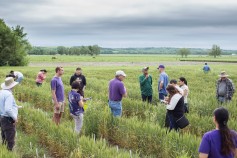Breadcrumb
- Home
- Recent news stories
- Wheat takes a walk on the wild side
Tucked quietly away in the Kansas Wheat Innovation Center is a treasure trove of genetics from around the globe. The Wheat Genetics Resource Center (WGRC) is an internationally-recognized gene bank that curates and houses more than 247,500 seeds from 2,500 wheat and wild wheat species accessions. While maintaining the collection in a climate and humidity controlled environment is an important cornerstone of the WGRC, it is not the only function of the organization.

WGRC scientists showed off their work to a crowd at the Rocky Ford Experiment Station. Photo by Haley Ahlers.
While growing these species provides a walk on the wild side for spectators, these plants are meant for teaching and research. One trait that scientists are looking for is resistance to leaf rust. The foliar disease is one that is familiar to Kansas famers, with the bright orange pustules causing up to 20% yield loss, but it is also a devastating disease found worldwide. WGRC scientists inoculate the plants with a composite of leaf rust strains and monitor the susceptibility of the plant to the disease. Useful genes like leaf rust resistance, as well as a number of others, are identified and then transferred to modern, agronomically useful breeding lines.
Included in the selection were 40 lines of diverse tauschii plants, a very close relative that crosses readily with wheat, and is a major source of genes for disease and pest resistance.“There is valuable genetic information hidden in these plants that we’re trying to explore and use,” said Duane Wilson, associate scientist at the WGRC.
The genes may be diverse, many of these lines may look similar to the untrained eye, but will have differences both large and small. Traits as minute as small “hairs” on leaves or awn length could be the deciding factor between identification of two species.
“With each species there is one particular trick to identification,” said Jon Raupp, senior scientist at the WGRC. “But there will be some species that you’ll just never get right away.”
Some some wild species thrive in the Kansas environment, but others don’t fare as well. Wilson reported that last year’s plots suffered from tremendous winterkill while the species planted this year handled the weather much better. Most of the species were headed and flowering at the time of the field day, but several of the wild wheat relatives were “late bloomers.” While this sounds like a mundane detail to most, WGRC scientists see potential to use possible early or late maturity genes in the next big wheat variety.“This is the most active collection of its kind in the world,” said Wilson. “Lots of places just hold their collections, but we hold and evaluate these species which can be very beneficial to farmers worldwide. The WGRC is an incredible valuable genetic resource.”
If you’re interested in a hands on experience with wheat varieties in your area, please visit a K-State Research and Extension Field Day near you. More information, including a full list of dates and locations, can be found at http://kswheatalliance.org/news-events/plot-tours-2016/.
Story by Jordan Hildebrand
